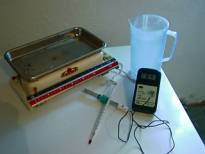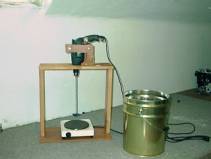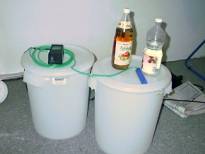
![]()
Search the Journey to Forever website – click HERE
|
Journey to Forever: Make a donation |
En español
Biocombustibles, biodiesel
Navigation
Contact usTo Keith Addison Handmade Projects |
The two-stage adaptation of Mike Pelly’s biodiesel recipe
By Aleks Kac
Spanish version -- Versión en español
The original 2-stage base/base method – uploaded 31 October 2000.
Note: The two-stage processes are advanced methods, not for beginners -- learn the basics thoroughly first. The single-stage base method is the place to start. Start here.
Introduction
 For some time now a growing group of people have been trying and succeeding to make diesel fuel out of used cooking oil (waste vegetable oil, WVO) by themselves. There are many magnificent articles on this subject on the Internet that can teach you how to get started.
For some time now a growing group of people have been trying and succeeding to make diesel fuel out of used cooking oil (waste vegetable oil, WVO) by themselves. There are many magnificent articles on this subject on the Internet that can teach you how to get started.
Here is a proposition for an alternative method, which can give you a slightly purer type of biodiesel. It will come in handy during winters, as with this adaptation less wax and ignition problems will arise -- at least I hope so.
 I believe that everyone has paid a visit to Mike Pelly's recipe at some point in their DIY biofuel-production learning stage -- if you haven't you should do it soon. This article will give you a good explanation of the ester splitting process, transesterification and soap formation. Also Mike provides a very good starting point for the first batches and the engine goes good enough on the fuel for most climates -- and for most drivers.
I believe that everyone has paid a visit to Mike Pelly's recipe at some point in their DIY biofuel-production learning stage -- if you haven't you should do it soon. This article will give you a good explanation of the ester splitting process, transesterification and soap formation. Also Mike provides a very good starting point for the first batches and the engine goes good enough on the fuel for most climates -- and for most drivers.
But I wasn't always quite happy with my product. Let me explain why: I am a chemistry technician and I did some calculation prior to my first biodiesel batches. I was missing a part of glycerine -- not much, but this was sloppy chemistry for me. I brewed, I weighed, I measured, I read articles, I reread them, I rebrewed and I bought a diesel car to try the biodiesel out.
Since no one at our Biofuel discussion group complained about this "missed" glycerine, I thought I must have gone wrong in my calculations and just poured the soup into my "brand new" used Jeep. I started the engine and went for a ride. Engine and pump didn't choke on the stuff, I happily noticed "The Smell" and started cooking some more.
But over time I noticed a slight nailing sound from the engine on fresher mornings and started to research. After a while I stumbled over Camillo Holecek's mail -- you know, the guy with the continuous process -- and this man gave me some good advice.
Theory
Well, if you remember your chemistry class, in many chemical reactions we know of a thing called equilibrium (some reactions go in one direction only). Let's look at a reaction like this:
A+B —> C+D
A+B <— C+D
As you noticed, the reaction direction is reversible, and of this type is also the transesterification reaction we like and do so much. When reactants and products reach equilibrium, the reaction stops. We don't like that, because it means that the WVO isn't converting anymore. Now our biodiesel is a mixture of WVO and FAME (fatty acid methyl ester). You can't tell these two apart, because FAME is a good solvent and thus the unreacted WVO is dissolved. We all know that you shouldn't run a regular diesel engine on unheated WVO, so we have to do something.
The adaptation
There are two remedies for that. Let's imagine that C and D represent our products: FAME and glycerine (A and B stand for WVO and methanol). To push the reaction towards C and D -- meaning, we want to convert all the WVO to FAME -- we can do the following:
- add more methanol -- this will push the reaction to the right, or
- retract the undesired product (glycerine) -- right direction again.
Adding methanol doesn't do much, unless you really exaggerate, meaning, you must add more than twice the amount needed to get a slight result. This will make the price of your homemade fuel go sky-high. But, retracting glycerine is another story, as it helps to pull out one third more. This means that more WVO gets transesterificated. Pulling out glycerine during the reaction is hard because you need a liquid-liquid separator (centrifuge) to do that, and this equipment is very expensive. I almost abandoned this idea, when Camillo offered a fine and simple solution: do it in two stages!
The process
Let's sum up Mike's process quickly:
- titrate
- heat up the WVO
- prepare the methoxide
- mix WVO and methoxide
- settle and retract glycerine
- wash and dry.
The two-stage process differs in only two things: no titration and a second mix of methoxide and WVO. First things first: why no titration? Well, any analytic chemist will tell you that if you don't work with fresh chemicals and in at least three parallels, you won't get accurate results. So I figured out an empiric quantity of lye (NaOH), which for all my batches was more than good: around 6.25 g of NaOH per litre of waste oil. For the second stage you don't need any new equipment, just some more time. OK, here is how it's done:
CAUTION:
Wear proper chemical-proof gloves, apron, and eye protection and do not inhale any vapors. Methanol can cause blindness and death, and you don't even have to drink it, it's absorbed through the skin. Sodium hydroxide can cause severe burns and death. Together these two chemicals form sodium methoxide. This is an extremely caustic chemical. These are dangerous chemicals -- treat them as such! Always have a hose running when working with them. The workspace must be thoroughly ventilated. No children or pets allowed. See Safety for further information.
First stage
1. Measure your WVO and pour it into your reaction vessel
2. Prepare your methoxide this way: mix 25% (by volume of WVO) of pure methanol and (6.25g/litre of WVO) of sodium lye (NaOH)
3. Heat the WVO to 48-52 deg C (118-126 deg F)
4. Add 3/4 of the prepared methoxide (save the rest in a sealed container out of reach of children and flames, sparks... or prepare a fresh batch for the next stage -- do two calculations: first determine the amount of needed chemicals, then split it in 3/4 and 1/4).
5. Mix for 50-60 minutes holding the initial temperature.
6. Let the mixture rest for 12 hours.
7. Separate the glycerine from the FAME -- you'll notice that at this point the glycerine is unusually thin.
Second stage
8. Refill your reaction vessel with the first-stage FAME.
9. Heat the FAME to 48-52 deg C (118-126 deg F).
10. Add the remaining 1/4 methoxide.
11. Mix for 50-60 minutes holding the initial temperature.
12. Let the mixture rest for 12 hours.
13. Separate the glycerine from the FAME -- now the glycerine is a gelatinous mass. On top of the glycerine layer you'll find a thick layer of settled waxes (cream colored), which you shouldn't process further. Remember, this is one of the things that might clog your fuel injectors.
14. Wash and dry with your favorite method. I use the Idaho bubble wash method.
The University of Idaho's Bubble wash method
I would like to explain this method in this article, because it is crucial that your product is washed. Please, do not attempt to drive your vehicle with fuel made on this article's instructions before it's properly washed (the fuel, not the car). This fuel is highly caustic at the end of the second stage and it could damage the high-pressure fuel pump.
Here is what you'll need: a large plastic vessel (twice the volume of your reaction vessel), a cheap aquarium air pump (with enough air flow), a large aquarium air stone and some rubber hose to connect the pump with the stone. I use a pH meter for my measurements, but you can use pH paper (scaled 1/2 pH unit) or a digital pH indicator (around US$15). The pH indicator is the cheapest instrument if you plan to make more than 20 batches.
pH explained
pH has no real unit, as it's formula is "pH= –log (conc. (H+)ions)". So this is a number that is not affected by volume, as chemists needed a way of telling how much H- or H+ ions there are in an unknown volume of a liquid.
The pH of your second-stage FAME will be well over 7 (surplus lye), which is a sort of zero on the pH scale. The scale ranges from 0 to 14, acidic is 0 through 7, from 7 up it shows alkalinity, 7 itself is neutral.
So, if you have, say, 10 litres of a liquid with a pH value of 9 (2 units above 7) and mix it with 10 litres of a liquid with a pH value of 5 (2 units under 7), the result will be a liquid with a pH value of more or less 7, meaning neutral. This trick we'll use to wash our FAME.
The Wash
First measure the pH of your FAME. Be patient, as it takes a little longer than with water mixtures. Write the value down. Prepare your washing vessel; fill it 1/2 with water (or with the same volume as the FAME you want to wash). Make sure that both the water and FAME have roughly the same (room) temperature. Now wash and dry the electrode of your indicator, dip it in the water and add strong vinegar till it reaches as many units under 7 as the FAME’s pH is above 7. Mix with a wooden spoon while adding minute amounts of vinegar.
the same volume as the FAME you want to wash). Make sure that both the water and FAME have roughly the same (room) temperature. Now wash and dry the electrode of your indicator, dip it in the water and add strong vinegar till it reaches as many units under 7 as the FAME’s pH is above 7. Mix with a wooden spoon while adding minute amounts of vinegar.
So, if your FAME’s pH is 8.7, the water should have a pH of 5.3. All well so far? Now pour your second-stage FAME into the vessel, throw in the aquarium stone and fire up the air pump. Soon you’ll notice a string of bubbles rising up through the FAME carrying minute amounts of water right to the surface. When this water falls down again, it washes the soaps and surplus methanol out of the FAME and the vinegar neutralizes the remaining lye.
Let it bubble for 6 hours minimum. Turn the pump off and let the mixture sit for 12 hours. The water will fall to the bottom, turning completely white and the fuel you made will look much lighter in color now. Take the FAME out of the vessel, taking care not to get any water with it. You can achieve that either with a translucent hose, or you can epoxy a valve to your vessel’s wall near the bottom. Now slowly heat the washed FAME to 100 deg C (212 deg F) and hold the temperature until you see no more steam bubbles rising. The pH of your homemade fuel will be 7 +/- 0.25, which is good enough. Cool it down, filter the fuel, pour it in your car’s tank and drive away.
See Washing
Conclusion
I tested biodiesel made by this method thoroughly in my Jeep Cherokee 2.1 litre turbodiesel. It behaves better than "classic" biodiesel, and even better than petrodiesel (the engine is grunting happily). Now that winter is on the doorstep, I will upgrade the fuel filter with a small heater, and that should eliminate other nasty little surprises.
As I’m finishing this article it got cold and it’s drizzling outside. I poured myself a finger of fine Scotch whiskey and I’m sipping it slowly. My cat is purring on my lap and I think very much of next spring, looking forward to some traveling. Hopefully we can all meet someday, possibly near a field of blooming sunflowers.
I wish you all good success with your biofuel production.
Aleks Kac
Ljubljana
Slovenija
Special thanks to:
Mike Pelly
Camillo Holecek
Steve Spence
Keith Addison
and Joshua Tickell
All of whom are true gentlemen.
Feedback
I received a number of complaints on the process, namely it seems to be generating a lot of "jelly". GET RID OF THE WATER! A more caustic methoxide in the process will absolutely generate soap in the presence of anything more 1 zillionth % of water. Here is the thing: the lye quantity is not obligatory 6.25 g/litre WVO. With this figure you'll get in trouble if the oil contains any water. For an easier start try 6.00 g/litre of WVO and gradually go up or preheat and dry your oil. More lye means easier ester splitting, less time.
© Aleks Kac 2000
Steve Spence
COMMENT
In one of Aleks Kac's first messages to the Biofuel mailing list he said he was making micro-batches of biodiesel, and the stuff he made from virgin oil was fine, "but with used fryer oil the ester smells like kitten vomit ... it has a real nasty smell, like when you open a compost heap. Any advice?" (It worked okay though.) It didn't take Aleks long to move from novice status to become one of the leading lights in the biofuels movement: it was only five months after this first message that he uploaded his two-stage biodiesel processing method to the Web. Good going Aleks -- keep up the great work!
-- Keith Addison
Mike Pelly
http://www.green-trust.org/
Joshua Tickell:
VeggieVan
http://www.veggievan.org/
Camillo Holecek of ENERGEA -- Email: camillo.holecek@donauwind.at
http://www.energea.at/en_info.html
Biofuels at Journey to Forever
Biofuel
En español -- Biocombustibles, biodiesel
Biofuels Library
Biofuels supplies and suppliers
Biodiesel
Make your own biodiesel
Mike Pelly's recipe
Two-stage biodiesel process
FOOLPROOF biodiesel process
Biodiesel processors
Biodiesel in Hong Kong
Nitrogen Oxide emissions
Glycerine
Biodiesel resources on the Web
Do diesels have a future?
Vegetable oil yields and characteristics
Washing
Biodiesel and your vehicle
Food or fuel?
Straight vegetable oil as diesel fuel
Ethanol
Ethanol resources on the Web
Is ethanol energy-efficient?